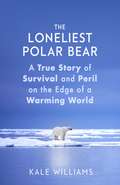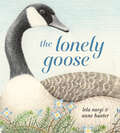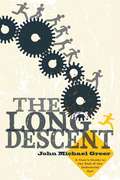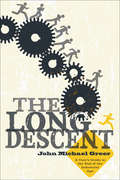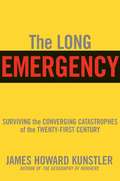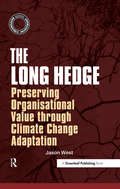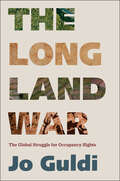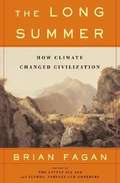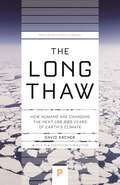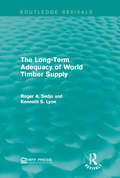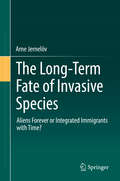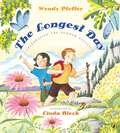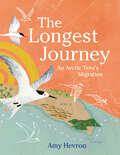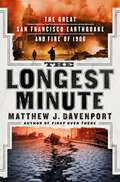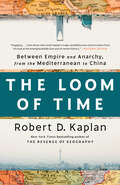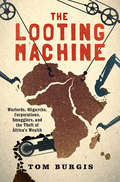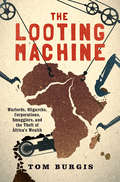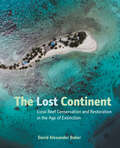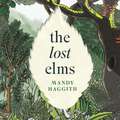- Table View
- List View
The Loneliest Polar Bear: A True Story of Survival and Peril on the Edge of a Warming World
by Kale WilliamsThe heartbreaking and ultimately hopeful story of an abandoned polar bear cub named Nora and the humans working tirelessly to save her and her species, whose uncertain future in the accelerating climate crisis is closely tied to our own. Six days after giving birth, a polar bear named Aurora got up and left her den at the Columbus Zoo, leaving her tiny, squealing cub to fend for herself. Hours later, Aurora still hadn't returned. The cub was furless and blind, and with her temperature dropping dangerously, the zookeepers entrusted with her care felt they had no choice: They would have to raise one of the most dangerous predators in the world themselves, by hand. Over the next few weeks, a group of veterinarians and zookeepers would work around the clock to save the cub, whom they called Nora.Humans rarely get as close to a polar bear as Nora's keepers got with their fuzzy charge. But the two species have long been intertwined. Three decades before Nora's birth, her father, Nanuq, was orphaned when an Inupiat hunter killed his mother, leaving Nanuq to be sent to a zoo. That hunter, Gene Agnaboogok, now faces some of the same threats as the wild bears near his Alaskan village of Wales, on the westernmost tip of the North American continent. As sea ice diminishes and temperatures creep up year-after-year, Gene and the polar bears--and everyone and everything else living in the far north--are being forced to adapt. Not all of them will succeed.Sweeping and tender, The Loneliest Polar Bear explores the fraught relationship humans have with the natural world, the exploitative and sinister causes of the environmental mess we find ourselves in, and how the fate of polar bears is not theirs alone.
The Lonely Goose
by Lela NargiIn this lyrical and poignant nonfiction book about loss, follow the lives of a pair of Canada geese as they perform their courtship rituals, raise nests full of chicks, and migrate with the seasons... until one goose has to brave the world alone.Here is how he won her over:He was the best dancer with the most powerful moves.He hissed loudly and bravely.He had a long, sleek neck and a fine bill.This is a stunningly illustrated, moving picture book about two geese bonded for life. They have six eggs, and then six chicks, and they teach them how to fly. But when one of the geese in the partnership becomes ill and dies, what happens to its partner goose? She is forced, suddenly, to brave the world on her own—until a new partner goose comes along, calling to her with his own powerful moves. With scientific facts, a beautiful text, and gorgeous art work, young readers will find themselves inspired to take a closer look at the natural world around them.
The Long Descent: A User's Guide to the End of the Industrial Age
by John Michael GreerAmericans are expressing deep concern about US dependence on petroleum, rising energy prices, and the threat of climate change. Unlike the energy crisis of the 1970s, however, there is a lurking fear that now the times are different and the crisis may not easily be resolved. The Long Descent examines the basis of such fear through three core themes: Industrial society is following the same well-worn path that has led other civilizations into decline, a path involving a much slower and more complex transformation than the sudden catastrophes imagined by so many social critics today. The roots of the crisis lie in the cultural stories that shape the way we understand the world. Since problems cannot be solved with the same thinking that created them, these ways of thinking need to be replaced with others better suited to the needs of our time. It is too late for massive programs for top-down change; the change must come from individuals. Hope exists in actions that range from taking up a handicraft or adopting an "obsolete" technology, through planting an organic vegetable garden, taking charge of your own health care or spirituality, and building community. Focusing eloquently on constructive adaptation to massive change, this book will have wide appeal. John Michael Greer is a certified Master Conserver, organic gardener, and scholar of ecological history. The current Grand Archdruid of the Ancient Order of Druids in America (AODA), his widely-cited blog, The Archdruid Report (thearchdruidreport.blogspot.com) deals with peak oil, among other issues. He lives in Ashland, Oregon.
The Long Descent: A User's Guide to the End of the Industrial Age
by John Michael GreerThe author of Dark Age America shares a harrowing vision of the future and what you can do to take action and make change.Americans are expressing deep concern about US dependence on petroleum, rising energy prices and the threat of climate change. Unlike the energy crisis of the 1970s, however, there is a lurking fear that, now, the times are different, and the crisis may not easily be resolved.The Long Descent examines the basis of such fear through three core themes:Industrial society is following the same well-worn path that has led other civilizations into decline, a path involving a much slower and more complex transformation than the sudden catastrophes imagined by so many social critics today.The roots of the crisis lie in the cultural stories that shape the way we understand the world. Since problems cannot be solved with the same thinking that created them, these ways of thinking need to be replaced with others better suited to the needs of our time.It is too late for massive programs for top-down change; the change must come from individuals.Hope exists in actions that range from taking up a handicraft or adopting an “obsolete” technology, through planting an organic vegetable garden, taking charge of your own health care or spirituality, and building community.Focusing eloquently on constructive adaptation to massive change, this book will have wide appeal.Praise for The Long Descent“At once erudite and entertaining, Greer’s exploration of the dynamics of societal collapse couldn’t be more timely.” —Richard Heinberg, Senior Fellow, Post Carbon Institute, and author of The Party’s Over and Peak Everything“Candidates for public office, and the voters who elect them, should be required to read [Greer’s] accurate diagnosis of the terminal illness our fossil-energy subsidized industrial civilization has too long denied. He shows how stubborn belief in perpetual progress blinded us to the abyss toward which we were speeding and thus impeded wise preparation for our unavoidable descent into a deindustrial age. We must hope that the array of mitigating tools he prescribes may yet render that descent down the back side of Hubbert’s peak less devastating than it will be if we insistently claim a right to be prodigal in using this finite Earth.” —Willam R. Catton, Jr., author of Overshoot: The Ecological Basis of Revolutionary Change
The Long Emergency
by James Howard KunstlerKunstler discusses the implications of peak oil, where oil production will eventually start to decrease as most of the easily-accessible oil has been used already. He gives some historical background and then discusses various proposed alternatives to oil and natural gas for providing transportation and electricity. He is skeptical that anything will be able to replace the abundant supply of energy that has been supplied by oil, with the possible exception of nuclear energy for electricity, and believes that the age of globalization will come to an end with declining standards of living. He discusses what he sees as the implications for different parts of the country and the world, each having their unique situations.
The Long Heat: Climate Politics When It’s Too Late
by Andreas Malm Wim CartonA scathing critique of proposals to geoengineer our way out of climate disaster, by the bestselling authors of OvershootThe world is crossing the 1.5°C global warming limit, perhaps exceeding 2°C soon after. What is to be done when these boundaries, set by the Paris Agreement, have been passed? In the overshoot era, schemes proliferate for muscular adaptation or for new technologies to turn the heat down at a later date by removing CO2 from the air or blocking sunlight. Such technologies are by no means safe; they come with immense risks and provide an excuse for those who would prefer to avoid limiting emissions in the present. But do they also hold out some potential? Can the catastrophe be reversed, masked or simply adapted to once it is a fact? Or will any such roundabout measures simply make things worse?The Long Heat maps the new front lines in the struggle for a liveable planet and insists on the climate revolution long overdue. In the end, no technology can absolve us of responsibility for our planet and each other.
The Long Hedge: Preserving Organisational Value through Climate Change Adaptation (The Responsible Investment Series)
by Jason WestPart of the Greenleaf Publishing Responsible Investment Series.Mitigating and adapting to risks and changing circumstances is a natural part of doing business. But methods of mitigating and adapting can be quite different in terms of time, cost and observed impacts. The impacts of mitigation activities are more immediate while the benefits of adaptation activities may take many years to take effect. Nowhere is this difference more apparent than in the case of the corporate response to climate change.In the context of climate change, adaptation is the process of changing behaviour in response to actual or expected climate change impacts. Climate change adaptation is now emerging as a critical partner to mitigation, and indeed may even become the primary protection mechanism for future generations.In this unique book, Jason West provides a comprehensive assessment of the management of climate change adaptation in the corporate sector. The book provides a formal overview of the range of approaches available along with a series of practical case studies and examples that can be used by companies and other organizations to identify, assess and manage climate change adaptation.A major focus is on the financial and investment implications of climate change adaptation. West examines how firms can evaluate the investment decisions associated with long-term climate change adaptation measures, including how such investments can be valued and funded, the appropriate accounting treatment of such measures and appropriate risk management and governance practices in relation to such measures. The book also considers the needs and interests of investors and other stakeholders, and considers how they can assess the adequacy and appropriateness of corporate action on climate change.The Long Hedge will be essential reading and a key text for risk-practitioners, investors, financiers, scholars and policy makers in the field of climate change.
The Long Land War: The Global Struggle for Occupancy Rights (Yale Agrarian Studies Series)
by Jo GuldiA definitive history of ideas about land redistribution, allied political movements, and their varied consequences around the world &“An epic work of breathtaking scope and moral power, The Long Land War offers the definitive account of the rise and fall of land rights around the world over the last 150 years.&” —Matthew Desmond, Pulitzer Prize–winning author of Evicted: Poverty and Profit in the American City Jo Guldi tells the story of a global struggle to bring food, water, and shelter to all. Land is shown to be a central motor of politics in the twentieth century: the basis of movements for giving reparations to formerly colonized people, protests to limit the rent paid by urban tenants, intellectual battles among development analysts, and the capture of land by squatters taking matters into their own hands. The book describes the results of state-engineered &“land reform&” policies beginning in Ireland in 1881 until U.S.-led interests and the World Bank effectively killed them off in 1974. The Long Land War provides a definitive narrative of land redistribution alongside an unflinching critique of its failures, set against the background of the rise and fall of nationalism, communism, internationalism, information technology, and free-market economics. In considering how we could make the earth livable for all, she works out the important relationship between property ownership and justice on a changing planet.
The Long Summer
by Brian M. FaganThe Long Summer illuminates the centuries-long pattern of human adaptation to the demands and challenges of an ever-changing climate-challenges that are still with us today.
The Long Thaw: How Humans Are Changing the Next 100,000 Years of Earth’s Climate (Princeton Science Library #44)
by David ArcherWhy a warmer climate may be humanity’s longest-lasting legacyThe human impact on Earth's climate is often treated as a hundred-year issue lasting as far into the future as 2100, the year in which most climate projections cease. In The Long Thaw, David Archer, one of the world’s leading climatologists, reveals the hard truth that these changes in climate will be "locked in," essentially forever.If you think that global warming means slightly hotter weather and a modest rise in sea levels that will persist only so long as fossil fuels hold out (or until we decide to stop burning them), think again. In The Long Thaw, David Archer predicts that if we continue to emit carbon dioxide we may eventually cancel the next ice age and raise the oceans by 50 meters. A human-driven, planet-wide thaw has already begun, and will continue to impact Earth’s climate and sea level for hundreds of thousands of years. The great ice sheets in Antarctica and Greenland may take more than a century to melt, and the overall change in sea level will be one hundred times what is forecast for 2100. By comparing the global warming projection for the next century to natural climate changes of the distant past, and then looking into the future far beyond the usual scientific and political horizon of the year 2100, Archer reveals the hard truths of the long-term climate forecast.Archer shows how just a few centuries of fossil-fuel use will cause not only a climate storm that will last a few hundred years, but dramatic climate changes that will last thousands. Carbon dioxide emitted today will be a problem for millennia. For the first time, humans have become major players in shaping the long-term climate. In fact, a planetwide thaw driven by humans has already begun. But despite the seriousness of the situation, Archer argues that it is still not too late to avert dangerous climate change--if humans can find a way to cooperate as never before.Revealing why carbon dioxide may be an even worse gamble in the long run than in the short, this compelling and critically important book brings the best long-term climate science to a general audience for the first time.With a new preface that discusses recent advances in climate science, and the impact on global warming and climate change, The Long Thaw shows that it is still not too late to avert dangerous climate change—if we can find a way to cooperate as never before.
The Long-Term Adequacy of World Timber Supply (Routledge Revivals)
by Roger A. Sedjo Kenneth S. LyonProjecting modest future growth for both prices and harvest levels, this study, first published in 1990, provides theoretical and empirical justification for challenging the conventional wisdom that real timber prices will rise for the indefinite future. The study presents fifty-year projections of regional and world harvest levels, world market price, and investments in forest regeneration by region. This book will be of particular interest to students of economics and environmental studies.
The Long-Term Fate of Invasive Species
by Arne JernelövThis book examines the long-term fate of invasive species by detailing examples of invaders from different zoological and botanical taxa from various places around the world. Readers will discover what happened, after a century or so, to 'classical' invaders like rabbits in Australia, house sparrows in North America, minks in Europe and water hyacinths in Africa and Asia. Chapters presented in the book focus on eighteen species in the form of in-depth case studies including: earthworms, zebra mussels, Canadian water weed, Himalayan balsam, house sparrows, rabbits, crayfish plague, Colorado beetles, water hyacinths, starlings, Argentine ant, Dutch elm disease, American mink, cane toad, raccoons, Canadian beavers, African killer bees and warty comb jelly. Invaded areas described are in Africa, Asia, Australia, Europe, North America, Pacific islands, and South America. Readers will get some ideas about the likely future of current invaders from the fate of old ones. This book is intended for undergraduates studying environmental sciences, researchers and members of environmental NGO's.
The Longest Day: Celebrating the Summer Solstice
by Wendy PfefferIn this fourth and final book in the series about seasons, Wendy Pfeffer turns her attention to summer, when butterflies emerge from silky cocoons and daylight hours stretch longer and longer. With lyrical prose and vibrant illustrations, The Longest Day takes us on a journey through the history and science behind the summer solstice, with a focus on summer celebrations from various cultures around the world. Teachers and students alike will treasure the varied and accessible knowledge, and activities in the back let everyone in on the festivities.
The Longest Journey: An Arctic Tern's Migration
by Amy HevronFollow the epic annual migration of an Arctic Tern on its sixty-thousand-mile journey to the South Pole and back again, the longest such migration in the animal kingdom. In their thirty-year lifetimes, Arctic Terns travel nearly 1.5 million miles, that&’s enough to fly to the Moon and back three times! Each year they brave blistering winds, storms, rough seas, and airborne predators as they travel between the Earth&’s poles, chasing the summer. In The Longest Journey: An Arctic Tern&’s Migration, we follow one such bird as it spreads its wings and sets out to make its first globe-spanning trip with its flock. Amy Hevron is the illustrator of Trevor by Jim Averbeck, the recipient of multiple starred reviews. She also illustrated Candace Fleming&’s The Tide Pool Waits which was the recipient of the Portfolio Honor Award from the Society of Children's Book Writers and Illustrators. Her brilliant, naturalistic artwork mimicking maps and nautical charts is supported by extensive research and paired with material at the back of the book explaining the science behind the life cycle of Arctic Terns. A Junior Library Guild Gold Standard Selection
The Longest Minute: The Great San Francisco Earthquake and Fire of 1906
by Matthew J. DavenportA New York Times Book Review Editor's ChoiceMatthew J. Davenport’s The Longest Minute is the spellbinding true story of the 1906 earthquake and fire in San Francisco, and how a great earthquake sparked a devastating and preventable firestorm.At 5:12 a.m. on April 18, 1906, a 7.9 magnitude earthquake struck San Francisco, catching most of the city asleep. For approximately one minute, shockwaves buckled streets, shattered water mains, collapsed buildings, crushed hundreds of residents to death and trapped many alive. Fires ignited and blazed through dry wooden ruins and grew into a firestorm. For the next three days, flames devoured collapsed ruins, killed trapped survivors, and nearly destroyed what was then the largest city in the American West.Meticulously researched and gracefully written, The Longest Minute is both a harrowing chronicle of devastation and the portrait of a city’s resilience in the burning aftermath of greed and folly. Drawing on the letters and diaries and unpublished memoirs of survivors and previously unearthed archival records, Matthew Davenport combines history and science to tell the dramatic true story of one of the greatest disasters in American history.
The Longest Race: A Lifelong Runner, An Iconic Ultramarathon, and the Case for Human Endurance
by Ed Ayres“It soon becomes clear that this book isn’t just about an athletic race. It’s also about the human race” (Bloomberg Businessweek). Having run in more than six hundred races over the span of fifty-five years, Ed Ayres is a legendary distance runner—and this book is his urgent exploration of the connection between individual endurance and a sustainable society. The Longest Race begins at the starting line of the 2001 JFK 50 Mile—the nation’s oldest and largest ultramarathon and, like other such races, it’s an epic test of human limits and aspiration. At age sixty, his sights set on breaking the age-division record, Ayres embarks on a course over the rocky ridge of the Appalachian Trail, along the headwind-buffeted towpath of the Potomac River, and past momentous Civil War sites such as Harpers Ferry and Antietam. But even as Ayres focuses on an endurance runner’s familiar concerns—starting strong and setting the right pace, controlling his breathing, overcoming fatigue, and staying mindful of the course ahead—he finds himself as preoccupied with the future of our planet as with the finish line. A veteran journalist and environmental editor, Ayres reveals how the skills and mindset necessary to complete an ultramarathon are also essential for grappling anew with the imperative to endure—not only as individuals, but as a society—and not just for fifty miles, but over the real long haul, in a unique meditation that “ought to be required reading even for people who have never run a step” (The Boston Globe). “He seamlessly moves between discussing running to exploring larger life issues such as why we run, our impact on the environment, and the effects of the nation’s declining physical fitness . . . Thought provoking.” ―Booklist “To read this book is to run alongside a seasoned athlete, a deep thinker, and a great storyteller. And Ayres doesn’t disappoint: He is the best kind of running companion, generously doling out hilarious stories and hard-won insights into performance conditioning and the human condition. His lifetime of ultra-running and environmental writing drive his exploration of what keeps us running long distances―and what it might take to keep the planet from being run into the ground.” ―Nature Conservancy magazine
The Loom of Time: Between Empire and Anarchy, from the Mediterranean to China
by Robert D. KaplanA stunning exploration of the Greater Middle East, where lasting stability has often seemed just out of reach but may hold the key to the shifting world order of the twenty-first century&“Engaging . . . Even those who resist Kaplan&’s tragic sensibility have much to learn from his look at the emerging Middle East and its recent history.&”—National Review The Greater Middle East, which Robert D. Kaplan defines as the vast region between the Mediterranean and China, encompassing much of the Arab world, parts of northern Africa, and Asia, existed for millennia as the crossroads of empire: Macedonian, Roman, Persian, Mongol, Ottoman, British, Soviet, American. But with the dissolution of empires in the twentieth century, postcolonial states have endeavored to maintain stability in the face of power struggles between factions, leadership vacuums, and the arbitrary borders drawn by exiting imperial rulers with little regard for geography or political groups on the ground. In the Loom of Time, Kaplan explores this broad, fraught space through reporting and travel writing to reveal deeper truths about the impacts of history on the present and how the requirements of stability over anarchy are often in conflict with the ideals of democratic governance. In The Loom of Time, Kaplan makes the case for realism as an approach to the Greater Middle East. Just as Western attempts at democracy promotion across the Middle East have failed, a new form of economic imperialism is emerging today as China's ambitions fall squarely within the region as the key link between Europe and East Asia. As in the past, the Greater Middle East will be a register of future great power struggles across the globe. And like in the past, thousands of years of imperial rule will continue to cast a long shadow on politics as it is practiced today. To piece together the history of this remarkable place and what it suggests for the future, Kaplan weaves together classic texts, immersive travel writing, and a great variety of voices from every country that all compel the reader to look closely at the realities on the ground and to prioritize these facts over ideals on paper. The Loom of Time is a challenging, clear-eyed book that promises to reframe our vision of the global twenty-first century.
The Looting Machine
by Tom BurgisThe trade in oil, gas, gems, metals and rare earth minerals wreaks havoc in Africa. During the years when Brazil, India, China and the other "emerging markets” have transformed their economies, Africa’s resource states remained tethered to the bottom of the industrial supply chain. While Africa accounts for about 30 per cent of the world’s reserves of hydrocarbons and minerals and 14 per cent of the world’s population, its share of global manufacturing stood in 2011 exactly where it stood in 2000: at 1 percent. In his first book, The Looting Machine, Tom Burgis exposes the truth about the truth about the African development miracle: for the resource states, it's a mirage. The oil, copper, diamonds, gold and coltran deposits just attract a global network of traders, bankers, corporate extractors and investors who combine with venal political cabals to loot the states' value . And the vagaries of resource-dependent economies could pitch Africa’s new middle class back into destitution just as quickly as they climbed out of it. The ground beneath their feet is as precarious as a Congolese mine shaft; their prosperity could spill away like crude from a busted pipeline. This catastrophic social disintegration is not merely a continuation of Africa’s past as a colonial victim. The looting now is accelerating as never before. As global demand for Africa’s resources rises, a handful of Africans are becoming legitimately rich but the vast majority, like the continent as a whole, are being fleeced. Outsiders tend to think of Africa as a great drain of philanthropy. But look more closely at the resource industry and the relationship between Africa and the rest of the world looks rather different. In 2010, fuel and mineral exports from Africa were worth $333 billion, more than seven times the value of the aid that went in the opposite direction. But who received the money? For every Frenchwoman who dies in childbirth, 100 die in Niger alone, the former French colony whose uranium fuels France’s nuclear reactors. In petro-states like Angola three-quarters of government revenue comes from oil. The government is not funded by the people, and as result it is not beholden to them. A score of African countries whose economies depend on resources are rentier states; their people are largely serfs. The resource curse is not merely some unfortunate economic phenomenon, the product of an intangible force. What is happening in Africa’s resource states is systematic looting. Like its victims, its beneficiaries have names.
The Looting Machine
by Tom BurgisThe trade in oil, gas, gems, metals and rare earth minerals wreaks havoc in Africa. During the years when Brazil, India, China and the other "emerging markets” have transformed their economies, Africa’s resource states remained tethered to the bottom of the industrial supply chain. While Africa accounts for about 30 per cent of the world’s reserves of hydrocarbons and minerals and 14 per cent of the world’s population, its share of global manufacturing stood in 2011 exactly where it stood in 2000: at 1 percent. In his first book, The Looting Machine, Tom Burgis exposes the truth about the truth about the African development miracle: for the resource states, it's a mirage. The oil, copper, diamonds, gold and coltran deposits just attract a global network of traders, bankers, corporate extractors and investors who combine with venal political cabals to loot the states' value . And the vagaries of resource-dependent economies could pitch Africa’s new middle class back into destitution just as quickly as they climbed out of it. The ground beneath their feet is as precarious as a Congolese mine shaft; their prosperity could spill away like crude from a busted pipeline. This catastrophic social disintegration is not merely a continuation of Africa’s past as a colonial victim. The looting now is accelerating as never before. As global demand for Africa’s resources rises, a handful of Africans are becoming legitimately rich but the vast majority, like the continent as a whole, are being fleeced. Outsiders tend to think of Africa as a great drain of philanthropy. But look more closely at the resource industry and the relationship between Africa and the rest of the world looks rather different. In 2010, fuel and mineral exports from Africa were worth $333 billion, more than seven times the value of the aid that went in the opposite direction. But who received the money? For every Frenchwoman who dies in childbirth, 100 die in Niger alone, the former French colony whose uranium fuels France’s nuclear reactors. In petro-states like Angola three-quarters of government revenue comes from oil. The government is not funded by the people, and as result it is not beholden to them. A score of African countries whose economies depend on resources are rentier states; their people are largely serfs. The resource curse is not merely some unfortunate economic phenomenon, the product of an intangible force. What is happening in Africa’s resource states is systematic looting. Like its victims, its beneficiaries have names.
The Looting Machine: Warlords, Oligarchs, Corporations, Smugglers, and the Theft of Africa's Wealth
by Tom BurgisThe trade in oil, gas, gems, metals and rare earth minerals wreaks havoc in Africa. During the years when Brazil, India, China and the other "emerging markets” have transformed their economies, Africa’s resource states remained tethered to the bottom of the industrial supply chain. While Africa accounts for about 30 per cent of the world’s reserves of hydrocarbons and minerals and 14 per cent of the world’s population, its share of global manufacturing stood in 2011 exactly where it stood in 2000: at 1 percent. In his first book, The Looting Machine, Tom Burgis exposes the truth about the African development miracle: for the resource states, it's a mirage. The oil, copper, diamonds, gold and coltan deposits attract a global network of traders, bankers, corporate extractors and investors who combine with venal political cabals to loot the states' value. And the vagaries of resource-dependent economies could pitch Africa’s new middle class back into destitution just as quickly as they climbed out of it. The ground beneath their feet is as precarious as a Congolese mine shaft; their prosperity could spill away like crude from a busted pipeline. This catastrophic social disintegration is not merely a continuation of Africa’s past as a colonial victim. The looting now is accelerating as never before. As global demand for Africa’s resources rises, a handful of Africans are becoming legitimately rich but the vast majority, like the continent as a whole, is being fleeced. Outsiders tend to think of Africa as a great drain of philanthropy. But look more closely at the resource industry and the relationship between Africa and the rest of the world looks rather different. In 2010, fuel and mineral exports from Africa were worth $333 billion, more than seven times the value of the aid that went in the opposite direction. But who received the money? For every Frenchwoman who dies in childbirth, 100 die in Niger alone, the former French colony whose uranium fuels France’s nuclear reactors. In petro-states like Angola three-quarters of government revenue comes from oil. The government is not funded by the people, and as result it is not beholden to them. A score of African countries whose economies depend on resources are rentier states; their people are largely serfs. The resource curse is not merely some unfortunate economic phenomenon, the product of an intangible force. What is happening in Africa’s resource states is systematic looting. Like its victims, its beneficiaries have names.
The Los Angeles Plaza
by William David EstradaCity plazas worldwide are centers of cultural expression and artistic display. They are settings for everyday urban life where daily interactions, economic exchanges, and informal conversations occur, thereby creating a socially meaningful place at the core of a city. At the heart of historic Los Angeles, the Plaza represents a quintessential public space where real and imagined narratives overlap and provide as many questions as answers about the development of the city and what it means to be an Angeleno. The author, a social and cultural historian who specializes in nineteenth- and early twentieth-century Los Angeles, is well suited to explore the complex history and modern-day relevance of the Los Angeles Plaza. From its indigenous and colonial origins to the present day, Estrada explores the subject from an interdisciplinary and multiethnic perspective, delving into the pages of local newspapers, diaries and letters, and the personal memories of former and present Plaza residents, in order to examine the spatial and social dimensions of the Plaza over an extended period of time. The author contributes to the growing historiography of Los Angeles by providing a groundbreaking analysis of the original core of the city that covers a long span of time, space, and social relations. He examines the impact of change on the lives of ordinary people in a specific place, and how this change reflects the larger story of the city.
The Lost Continent: Coral Reef Conservation and Restoration in the Age of Extinction
by David Alexander BakerThis poignant tribute to the beauty of coral reefs sheds light on the destruction of global reef ecosystems and the climate science behind the conservation efforts to save them.Broken into three parts—Discovering Corals, Wonder and Devastation, and Searching for Hope—and told through a series of gripping stories, author and documentarian David Alexander Baker takes readers on a global adventure to the front lines of an unfolding ecological crisis. More than half of the world's coral reefs have been destroyed in the past fifty years due to the climate crisis. The Lost Continent helps readers gain a deeper understanding of coral reefs and why they are vital to the health of our oceans—and the survival of our planet—and highlights the incredible conservation and restoration strides being made around the world. With over 60 breathtaking photographs of coral reefs spanning from Colombia to Australia to the Florida Keys readers will be moved both by the majesty of nature and the urgency to preserve and restore these great cities of the seas.
The Lost Elms: The stunning new nature book from the 'unofficial poet laureate of our woodlands'
by Dr Mandy Haggith'Unofficial poet laureate of our woodlands.' - THE SCOTSMAN'Not just an elegy to our lost elms but also a meditation on life, culture and trees.' - FRED PEARCEFor millennia, elms shaped our landscape and our folklore; then they started dying.For the past century, a deadly pandemic has raged across the world, destroying all in its path and outmanoeuvring scientists' desperate attempts to halt it.Dutch elm disease has killed hundreds of millions of trees globally and over 25 million in the UK alone, altering our landscapes forever. Few young people have seen a mature elm tree, yet they once covered great swathes of Europe and North America and their legacy lives on in our mythology.The Lost Elms is a love letter to our vanished elms - the story of how we have nearly lost them all, and the long, slow fight back. It tells the gripping story of the scientists desperately trying to halt the disease's relentless progress, and demonstrates the deadly effect globalisation can have on the environment, the threat of climate change, the importance of biosecurity and the intricate ways in which trees are interlinked with other species. Woven throughout is a lyrical look at the elm's central place in our history, culture and folklore - the elm features heavily in Greek, Celtic, Japanese, Germanic and Scandinavian mythology; as the 'Liberty Tree' it played a symbolic role in both the American and French Revolutions; and since ancient times the elm has held associations with death and the supernatural.However all is not lost: recent breakthroughs in ecological understanding reveal elms to be far more resilient than we ever imagined. This tree holds an important place in our history, and now might just offer hopeful lessons for how we can save other disappearing species and our environment.
The Lost Elms: The stunning new nature book from the 'unofficial poet laureate of our woodlands'
by Dr Mandy Haggith'Unofficial poet laureate of our woodlands.' - THE SCOTSMAN'Not just an elegy to our lost elms but also a meditation on life, culture and trees.' - FRED PEARCEFor millennia, elms shaped our landscape and our folklore; then they started dying.For the past century, a deadly pandemic has raged across the world, destroying all in its path and outmanoeuvring scientists' desperate attempts to halt it.Dutch elm disease has killed hundreds of millions of trees globally and over 25 million in the UK alone, altering our landscapes forever. Few young people have seen a mature elm tree, yet they once covered great swathes of Europe and North America and their legacy lives on in our mythology.The Lost Elms is a love letter to our vanished elms - the story of how we have nearly lost them all, and the long, slow fight back. It tells the gripping story of the scientists desperately trying to halt the disease's relentless progress, and demonstrates the deadly effect globalisation can have on the environment, the threat of climate change, the importance of biosecurity and the intricate ways in which trees are interlinked with other species. Woven throughout is a lyrical look at the elm's central place in our history, culture and folklore - the elm features heavily in Greek, Celtic, Japanese, Germanic and Scandinavian mythology; as the 'Liberty Tree' it played a symbolic role in both the American and French Revolutions; and since ancient times the elm has held associations with death and the supernatural.However all is not lost: recent breakthroughs in ecological understanding reveal elms to be far more resilient than we ever imagined. This tree holds an important place in our history, and now might just offer hopeful lessons for how we can save other disappearing species and our environment.
The Lost Elms: The stunning new nature book from the 'unofficial poet laureate of our woodlands'
by Dr Mandy Haggith'Unofficial poet laureate of our woodlands.' - THE SCOTSMAN'Not just an elegy to our lost elms but also a meditation on life, culture and trees.' - FRED PEARCEFor millennia, elms shaped our landscape and our folklore; then they started dying.For the past century, a deadly pandemic has raged across the world, destroying all in its path and outmanoeuvring scientists' desperate attempts to halt it.Dutch elm disease has killed hundreds of millions of trees globally and over 25 million in the UK alone, altering our landscapes forever. Few young people have seen a mature elm tree, yet they once covered great swathes of Europe and North America and their legacy lives on in our mythology.The Lost Elms is a love letter to our vanished elms - the story of how we have nearly lost them all, and the long, slow fight back. It tells the gripping story of the scientists desperately trying to halt the disease's relentless progress, and demonstrates the deadly effect globalisation can have on the environment, the threat of climate change, the importance of biosecurity and the intricate ways in which trees are interlinked with other species. Woven throughout is a lyrical look at the elm's central place in our history, culture and folklore - the elm features heavily in Greek, Celtic, Japanese, Germanic and Scandinavian mythology; as the 'Liberty Tree' it played a symbolic role in both the American and French Revolutions; and since ancient times the elm has held associations with death and the supernatural.However all is not lost: recent breakthroughs in ecological understanding reveal elms to be far more resilient than we ever imagined. This tree holds an important place in our history, and now might just offer hopeful lessons for how we can save other disappearing species and our environment.
